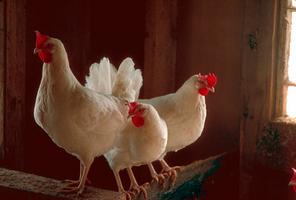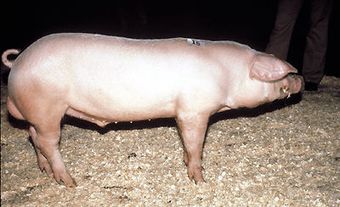
Poultry Farming
Poultry are domesticated birds kept for their meat or eggs. Common varieties in Canada are chickens (Gallus gallus or Gallus domestica, family Phasianidae), turkeys (Meleagris gallopavo, family Phasianidae), ducks (Anasplatyrhynchos, Cairina moschata, family Anatidae) and geese (genus Anser, family Anatidae). Chicken producers are distributed as follows: British Columbia 318, Alberta 310, Saskatchewan 93, Manitoba 117, Ontario 1075, Québec 747, New Brunswick 35, Nova Scotia 82, Prince Edward Island 7 and Newfoundland 8. Turkey producers are distributed as follows: British Columbia 64, Alberta 51, Saskatchewan 15, Manitoba 64, Ontario 186, Québec 135, New Brunswick 18, Nova Scotia 24, Prince Edward Island 0 and Newfoundland 0. Egg producers are distributed as follows: British Columbia 126, Alberta 167, Saskatchewan 64, Manitoba 168, Ontario 359, Québec 105, New Brunswick 17, Nova Scotia 23, Prince Edward Island 12 and Newfoundland 11. The farm cash receipts of Canadian poultry products are about $2.6 billion annually, contributing more than 7% of cash receipts to farming operations. Canada exports more than 35.4 million heads of chicks, poults (young turkeys), domestic fowl, turkeys, ducks, geese and guinea fowl worth $36 million to 22 countries.
Foundation breeders have developed hybrid strains of chickens for commercial egg and meat production; to a lesser degree, the same has been done for turkey meat production; little breeding work has been done on waterfowl. Foundation breeders must keep pure bloodlines for crossing; however, most purebreds are kept as a hobby by poultry fanciers or exhibition poultrymen. The only world-class foundation breeding companies in Canada are Shaver Poultry Breeding Farms Ltd, Cambridge, Ont, and Hybrid Turkeys Ltd, Kitchener, Ont. However, nearly all foundation breeders worldwide sell parent stock to franchised hatcheries in Canada, which, in turn, supply commercial stock to poultry producers.
Chickens
The basic white egg producing breed is the White Leghorn, while brown eggs are produced by hybrids based on several breeds, most notably the Rhode Island Red, Barred Plymouth Rock and New Hampshire. The commercial white egg layer is white feathered and weighs about 1.8 kg. Brown egg layers are coloured and weigh slightly more. Laying chickens produce 300 to 340 eggs during the 12 to 13 months they are in lay. They are expected to produce one dozen eggs for every 1.55 kg of feed. Broiler birds (for meat) are produced from crosses that originally involved White Plymouth Rock and/or New Hampshire for the mother side and Cornish for the father side.
The commercial broiler is white feathered, fast growing, vigorous and well fleshed. Chicken broilers are generally slaughtered when 35 days old, at a live weight of 2.1 kg. They require 1.8 kg of feed to produce 1 kg live weight. Currently, 2 international companies supply the large majority of the industrial market for both layer and broiler chickens.
Turkeys
The Broad Breasted Large White breed was developed in the early 1950s, through pedigree breeding and selection at Cornell University from crosses of Broad Breasted Bronze and White Holland. Private breeders soon began to develop other strains through crossbreeding. The Beltsville Small White variety was developed by the US Department of Agriculture at the Agricultural Research Centre in Beltsville, Maryland, between 1941 and 1962. This stock has been distributed throughout the world. It is smaller in size and is generally better in egg production, fertility and hatchability; it is usually less broody than larger-sized varieties. When marketed as broilers, these birds are usually slaughtered at 10 to 11 weeks of age. The same 2 companies referred to in the chicken segment also supply the large majority of global turkey stock.
Ducks and Geese
Purebreds and crosses are the sources of commercial stock. The White Pekin is the most popular meat duck; the Muscovy is also used to a limited extent, especially in crosses to the White Pekin. The 3 most popular breeds of geese are Embden, Chinese and Toulouse. Poultry farms may be classed as producers of eggs, chicken meat, turkey, waterfowl or game and exotic birds. Production of eggs, chicken meat and turkey is regulated federally (Agricultural Products Marketing Act) and provincially (Agricultural Marketing Boards). Federal agencies allocate production quotas to the provinces, remove market surpluses and regulate import and export of products. Provincial boards allocate production quotas to producers, set prices, advertise the product and deduct board levies from producers for operating costs. The general strategy is to ensure that each province is self-sufficient. Waterfowl and the relatively new game bird and exotic bird production have little control and few statistics are available.

 Share on Facebook
Share on Facebook Share on X
Share on X Share by Email
Share by Email Share on Google Classroom
Share on Google Classroom


